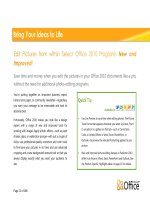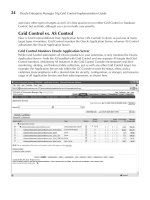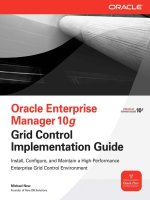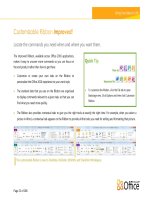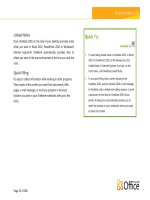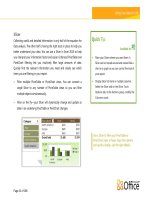Microsoft dynamics AX implementation guide
Bạn đang xem bản rút gọn của tài liệu. Xem và tải ngay bản đầy đủ của tài liệu tại đây (9.91 MB, 348 trang )
www.allitebooks.com
Microsoft Dynamics AX
Implementation Guide
Your all-in-one guide to exploring and implementing
Microsoft Dynamics AX
Yogesh Kasat
JJ Yadav
professional expertise distilled
P U B L I S H I N G
BIRMINGHAM - MUMBAI
www.allitebooks.com
Microsoft Dynamics AX Implementation Guide
Copyright © 2015 Packt Publishing
All rights reserved. No part of this book may be reproduced, stored in a retrieval
system, or transmitted in any form or by any means, without the prior written
permission of the publisher, except in the case of brief quotations embedded in
critical articles or reviews.
Every effort has been made in the preparation of this book to ensure the accuracy
of the information presented. However, the information contained in this book is
sold without warranty, either express or implied. Neither the authors, nor Packt
Publishing, and its dealers and distributors will be held liable for any damages
caused or alleged to be caused directly or indirectly by this book.
Packt Publishing has endeavored to provide trademark information about all of the
companies and products mentioned in this book by the appropriate use of capitals.
However, Packt Publishing cannot guarantee the accuracy of this information.
First published: September 2015
Production reference: 1140915
Published by Packt Publishing Ltd.
Livery Place
35 Livery Street
Birmingham B3 2PB, UK.
ISBN 978-1-78528-896-8
www.packtpub.com
www.allitebooks.com
Credits
Authors
Project Coordinator
Yogesh Kasat
Vijay Kushlani
JJ Yadav
Proofreader
Safis Editing
Reviewers
Palle Agermark
Indexer
Fatih Demirci
Stephanie Kroese
Ravi Shankar Kumar
Commissioning Editor
Priya Singh
Graphics
Sheetal Aute
Disha Haria
Abhinash Sahu
Acquisition Editors
Kevin Colaco
Production Coordinator
Nilesh R. Mohite
Neha Nagwekar
Content Development Editor
Anand Singh
Mariammal Chettiyar
Cover Work
Nilesh R. Mohite
Technical Editor
Parag Topre
Copy Editors
Sarang Chari
Sonia Mathur
www.allitebooks.com
About the Author
Yogesh Kasat is a cofounder of Real Dynamics, which is one of the first Microsoft
Dynamics AX IV&Vs (Independent Verification and Validation services provider).
The goal of Real Dynamics is to help businesses and their internal IT teams to take
their Dynamics AX implementation to the next level with independent and unbiased
recommendations.
Yogesh has led a number of large Dynamics AX implementations and turned them
into success stories. He has a unique blend of knowledge of financial and supply
chain modules, technical architecture, and business process optimization, and he
has held project management, leadership, and solution architect roles. Yogesh
is one of the founding partners of Real Dynamics—an organization focused on
providing independent guidance and oversight of Dynamics AX implementations,
post-implementation reviews, and help to customers in defining a roadmap for the
Dynamics AX platform. He held a leadership role for one of the leading Dynamics
AX partners as the vice president of Dynamics AX delivery and oversaw Dynamics
AX implementations throughout North America. He was awarded the prestigious
Leadership Award twice during his tenure with the company. He has six Dynamics
AX certifications, including financials, trade and logistics, and managing Dynamics AX
implementation (Sure Step). In addition to more than a decade's experience of working
on Dynamics AX, Yogesh has earlier experience with other business applications,
including Dynamics NAV/GP and PeopleSoft. He has traveled extensively for global
projects and has had the pleasure of visiting different parts of the world.
www.allitebooks.com
Acknowledgments
I would like to thank my mom for always being there and giving me lessons in
honesty and being truthful that have helped me at every stage of my career.
I would also like to thank my wife, Ashwini, who has supported me at every step in
life, bringing all the charm to my life. She has had the patience to allow me to take
some personal time away to work on this book, pursue challenging projects, and
travel like crazy, which have resulted in the many experiences mentioned in the
book. Big thanks also go to the rest of my family, friends, coworkers, and peers in the
industry for their input and inspiration.
My sincere thanks go to my coauthor and longtime coworker, JJ Yadav, and the
reviewer, Stephanie Kroese, for their efforts and ideas in the making of this book.
Special thanks to all the reviewers and Packt Publishing for providing valuable
feedback and comments during the making of this book.
Finally, thanks to my bosses, clients, and the people who provided guidance
in creating many success stories and helped me reach where I am in my
career—Sandeep Walia, Pankaj Kumar, Anwar Jiwani, George Van Rijn, Sri
Srinivasan, Kevin Scott, Henrik Bergholt, Paul Delahunty, Scott Ball, Petras
Petroskevicius, Vivek Garud, Rohit Kulkarni, Anil Daga, and Dwarkanath Kasat.
www.allitebooks.com
About the Author
JJ Yadav has worked on Microsoft Dynamics AX for more than a decade as a
solutions architect, project manager, technical lead, and developer. He started
working on Axapta 3.0 as a developer with Euro Info Systems in India (now Tectura
India). He has experience in leading and managing several Dynamics AX Global
implementations and upgrade projects. His core technical expertise in Dynamics AX
includes infrastructure planning, integration services, data migration, and workflow.
He has extensive functional experience in financials, procurement, accounts
payable, accounts receivable, inventory and warehouse management, and the
service modules of Dynamics AX. Currently, he works as a senior technical project
manager with Ignify in the central region of the U.S. on a leading Global AX 2012 R3
implementation project.
I would like to thank my family, friends, and coworkers for their
support and inspiration. My sincere thanks to my uncle, Radhe
Shyam, for his support during the most difficult time of my life;
without his support and inspiration, I would not be where I am today.
Finally, my beautiful wife, Khushboo, for supporting and encouraging
me at every walk of life and all the patience and support during the
hours and weekends that I spent writing this book.
My sincere gratitude to my longtime coworker and coauthor, Yogesh
Kasat, for coming up with the idea of writing this book and making
me a part of it. I would like to thank my reviewer, Stephanie Kroese,
all the other reviewers, and Packt Publishing for providing valuable
feedback and comments during the creation of this book.
www.allitebooks.com
About the Reviewers
Palle Agermark has worked as a developer and technical consultant with Concorde
XAL and Microsoft Dynamics AX for more than 20 years. He worked at Microsoft
Development Center Copenhagen for a number of years, primarily developing on the
financial, accounts payable, accounts receivable, and unit test modules.
Currently, Palle works for one of Scandinavia's largest Microsoft Dynamics AX
partners, EG, in Denmark.
He has been named a Microsoft Dynamics AX MVP for 2 consecutive years and
blogs about AX at .
Fatih Demirci (MCT) is a technical consultant, project manager, and Microsoft
Certified Trainer. He graduated in computer engineering. He has been working
professionally on Dynamics AX since 2006. During this period, he has worked for a
lot of Microsoft partners, customers, and projects. He has over 10 years of consulting
experience, playing a variety of roles, including senior software engineer, team
leader, trainer, technical consultant, and project manager at Dynamics AX. He is
a cofounder of DMR Consultancy, which is the most promising ERP consultancy
company in Turkey, and he works with some of the most experienced and creative
Dynamics AX professionals. Recently, he also reviewed another wonderful book,
Dynamics AX 2012 R3 Development Cookbook, Packt Publishing.
He runs a professional and technical blog at www.fatihdemirci.net and shares his
thoughts and readings on Twitter and LinkedIn.
I would like to thank my family and friends for motivating me and
always pushing me to do my best.
www.allitebooks.com
Stephanie Kroese is a solution architect and project manager with over 15
years of successful experience in managing IT organizations and leading projects,
in which she delivered significant business value. She has a broad experience in
the implementation, application, and delivery of ERP, strategic planning, and
project management. For 12 years, Stephanie was the senior IT leader for a global
battery manufacturer and was responsible for driving the strategic direction of the
organization toward supporting business growth. In addition, she has spent over 7
years implementing various ERP systems—the last 4 of which focused on Dynamics
AX—in certain global organizations as a senior consultant in project management,
functional analysis, report writing, training, and technical roles.
Ravi Shankar Kumar is a passionate professional, who is able to contribute a
unique blend of project management, delivery, sales, and exemplary problem-solving
skills, along with a commitment to excel in any job. He has an eye for detail in ensuring
that a project's mission and objectives are met within scope, budget, and schedule.
Ravi has exceptional organizational skills to coordinate with and manage multiple
stakeholders, along with the ability to work autonomously and prioritize his workload
to deal with conflicting demands. An adept understanding of business processes and
an organization's culture, combined with an aptitude for lateral thinking, enables
efficient management of project risks and deliverables.
Ravi has been working in the IT industry since 2001, and his passion at work has
been to assist companies to increase their usage of IT/ERP systems to improve
productivity, manage change, and conduct better business for their customers,
employees, and owners. He is a highly motivated and energetic person with a strong
commercial and systems background, including extensive experience in analyzing
business requirements and translating these into systems solutions. He is also
particularly strong in the project management discipline and has a very good record
of driving projects to their successful conclusion through the use of his interpersonal
and organizational skills, including negotiations at the executive management level.
Ravi has a consulting, functional, project management, and sales background and is
flexible enough to be able to maintain a sense of humor under pressure. He is poised
and competent with a demonstrable ability to easily handle cultural differences. In
addition to this, he is also passionate about providing the best solutions in order to
achieve business needs. Ravi is always keen to take up challenging assignments and
deliver solutions to the customer's satisfaction.
www.allitebooks.com
Lastly, during several DAX 2012 and 2009 projects, he practiced communication on
multiple levels, for example, from the CEO to a shop's ground staff. Ravi currently
works with one of the top Big Four firms in India.
I would like to thank my fellow authors and Packt Publishing
for giving me this opportunity. I look forward to many more
publications! I would also like to take this opportunity to thank my
mother, Shanti Sinha, and my beloved wife, Bharti Kumari, for their
continued support during the long hours of reviewing this book.
www.allitebooks.com
www.PacktPub.com
Support files, eBooks, discount offers, and more
For support files and downloads related to your book, please visit www.PacktPub.com.
Did you know that Packt offers eBook versions of every book published, with PDF and ePub
files available? You can upgrade to the eBook version at www.PacktPub.com and as a print
book customer, you are entitled to a discount on the eBook copy. Get in touch with us at
for more details.
At www.PacktPub.com, you can also read a collection of free technical articles, sign up for a
range of free newsletters and receive exclusive discounts and offers on Packt books and eBooks.
TM
/>Do you need instant solutions to your IT questions? PacktLib is Packt's online digital book
library. Here, you can search, access, and read Packt's entire library of books.
Why subscribe?
•
Fully searchable across every book published by Packt
•
Copy and paste, print, and bookmark content
•
On demand and accessible via a web browser
Free access for Packt account holders
If you have an account with Packt at www.PacktPub.com, you can use this to access PacktLib
today and view 9 entirely free books. Simply use your login credentials for immediate access.
Instant updates on new Packt books
Get notified! Find out when new books are published by following @PacktEnterprise on
Twitter or the Packt Enterprise Facebook page.
For my son Neel, who brings me feeling of winning the world with his cute smile.
– Yogesh Kasat
For my precious children, Hrehaan and Mira.
– JJ Yadav
Table of Contents
Prefacexi
Chapter 1: Preparing for a Great Start
1
Project kickoff
1
Managing customer expectations and commitments
2
Tips for customers
3
Customer environment and culture
4
Resources4
Consulting team resource alignment
Customer resource alignment
External resources
4
5
5
Establishing the team
6
The kickoff meeting
8
Project management and governance
9
The project plan
9
Communication10
Change control
11
Budget tracking
12
The view from the top
13
The Agile methodology
14
Summary14
Chapter 2: Getting into the Details Early
The requirement gathering techniques
The tools to use at this stage
15
16
16
Questionnaire
16
Lead19
Negotiate21
Conference Room Pilot (CRP)
Why is CRP needed?
Considerations for CRP success
22
22
23
[i]
Table of Contents
The CRP execution
23
The Fit/Gap analysis
24
The implementation strategy
25
Key deliverables from the analysis phase
26
Summary26
Chapter 3: Infrastructure Planning and Design
27
The Dynamics AX components and architecture
28
Databases29
The middle tier
29
Reporting and BI
30
Client30
The Help server
30
Capacity planning and infrastructure estimation
30
Capacity planning
31
The deployment details
31
Reports32
Operating sites and schedules
32
The ISV products
32
Customizations33
Integrations33
The batch process
33
Using Lifecycle Services – Usage Profiler
34
Infrastructure estimation
35
Planning the system topology
38
The production system topology
39
The nonproduction system topology
41
Cloud deployment
42
The cloud services
42
Microsoft Dynamics AX 2012 R3 on Azure
43
Industry best practices and recommendations
45
Planning
46
The SQL server
46
The AOS server
47
Reviews47
Summary48
Chapter 4: Integration Planning and Design
Integration planning
Integration scenarios
Integration requirements
Synchronous or asynchronous
[ ii ]
49
50
50
51
52
Table of Contents
Integration technologies
Application Integration Framework and services
The AIF architecture
Key concepts in AIF
Cloud-based integration
The Microsoft Dynamics AX 2012 Data Import/Export Framework
An ad hoc manual file import/export
Automated asynchronous integration
Master data management
53
53
54
55
58
59
60
60
61
.NET Framework – .NET Interop
62
The .NET Business Connector
63
The third-party integration solution
63
Connector for Microsoft Dynamics
64
Integration design and development
65
Selecting the right integration technology
65
Developing a high-level conceptual design
66
Defining field mapping
68
Development, configuration, and testing
69
Best practices and recommendations
69
Summary70
Chapter 5: Data Migration – Scoping through Delivery
Managing scope – simplifying data migration through rightsizing
the scope
Questions to ask during the scoping exercise
Leading the data migration requirements sessions
The battle of history
The design and development phase
Data mapping and transformation
Planning the data migration
Selecting the tools for data migration
How do I select the right tool?
Data migration versus data entry
Data import features developed on the project
71
72
72
73
75
76
77
77
79
79
79
79
The Data Import/Export Framework
80
Data migration execution tips
86
Terminologies81
Architecture81
A summary of key features
83
AIF84
Custom X++
85
Describing custom X++
85
Excel add-in
85
Describing an Excel add-in
86
Initial templates for business
86
[ iii ]
www.allitebooks.com
Table of Contents
Extracting source data into SQL tables
Never rename/repurpose fields
Considering premigration steps
Considering postmigration steps
Changing SQL to simple recovery mode
Multithreading and max DOP
Index and statistics maintenance
Disabling the AX logging
Considering SQL updates on migrated data
The SQL import – through caution and expertise
Managing configurations
Configuration management simplified with DIXF
Reviewing and deciding on the configuration
87
87
87
87
87
87
87
88
88
88
88
89
89
Data validation
90
A classic example of a data migration issue in projects
90
Summary92
Chapter 6: Reporting and BI
Gathering BI and reporting requirements
The top three customer issues in reporting
Inaccurate data and calculation
Performance
Layout and formatting
Knowing about reporting tools
SQL Server Reporting Services
93
93
95
96
96
96
96
97
Out-of-the-box SSRS reports
97
EP chart controls
Cues in Role Center
The AX auto-report wizard
Exporting to Excel from forms
Business intelligence/analytics – cubes
99
100
101
102
103
The Management Reporter tool
List pages
Office Add-ins
106
108
109
Accessing data from cubes
Word add-ins
Excel add-ins
104
109
110
Other add-on BI solutions
112
Mapping reports and identifying gaps
112
The custom report development
113
Development114
Testing115
Deployment
116
Summary116
[ iv ]
Table of Contents
Chapter 7: Functional and Technical Design
The functional design document
Why write FDD?
Fit/Gap review session
Project management aspects of design
Things to know before writing FDD
The party model
The global address book
The financial data
The reverse engineering tool
Key global features
Big picture diagrams
Do's and Don'ts
The solution design document
Overview and objectives
Guidelines for Solution Design Documents
Engaging ISV partners
Before choosing ISV solutions
After selecting the partner
Common pitfalls
The Technical Design Document
Overview and objectives
Guidelines for the Technical Design Document
117
118
118
119
119
120
121
122
122
123
123
128
131
132
132
133
133
134
135
135
136
136
136
Preparation
136
Execution
137
Outcome138
Summary138
Chapter 8: Configuration Management
Configuration planning
Collecting the configuration data
Configuration tools
The Data Import/Export Framework
Importing and exporting data using various formats
Copying and comparing data between legal entities
Copying data between Microsoft Dynamics AX instances
Creating a custom entity
139
140
143
144
144
144
144
145
145
The Microsoft Dynamics ERP RapidStart Services
The Excel add-in
Export/Import – DAT/DEF file
146
148
149
The LCS configuration manager – the beta version
152
The definition group
Defining the export criteria
Finding related tables
[v]
149
150
151
Table of Contents
The Test Data Transfer Tool – the beta version
153
Configuration data management
154
The golden environment
155
Copying the template company
156
Building configuration templates
156
Summary156
Chapter 9: Building Customizations
Getting ready for development
The version control
The development environment
The shared AOS topology
The private AOS topology
The TFS branching strategies
157
157
158
158
158
159
160
Ground rules for development
161
Development layers and models
AOT objects' naming conventions
Label files and language
Establishing the code review process
161
162
162
162
The development process
Conceptualization
Data design
163
163
164
Adding fields to the existing tables
Table Types
Table fields
Date effectivity
Table properties
Index considerations
Tables key considerations
The delete actions
164
165
167
168
169
171
174
175
The business logic
175
The user interface
182
The number sequence framework
The FormLetter framework
The RunBase framework
The SysOperation framework
Services and the Application Integration Framework (AIF)
Other application and development frameworks
Best practices to customize business processes
Client user interface guidelines
Enterprise portal user interface guidelines
Report user interface guidelines
176
176
176
177
177
178
180
182
186
188
Security192
Key concepts
192
Coding best practices
Best practice check
194
194
[ vi ]
Table of Contents
Naming variables and objects
194
Commenting the code
194
Labels and text
194
Database195
Transactions195
Exception handling
195
The Application Lifecycle Management (ALM)
196
Development
196
Creating the build
197
Testing/defect fixing
197
Release to production
197
Application Lifecycle guidelines and best practices
198
Summary199
Chapter 10: Performance Tuning
201
Performance testing and tuning
202
Preparing for the process
203
The execution stage
203
Outcome204
Tools for performance monitoring
205
The trace parser
205
The performance monitor
206
The performance analyzer – DynamicsPerf
207
The LCS system diagnostics
208
The performance benchmark SDK
210
The SQL Server Profiler
210
The SCOM pack for Microsoft Dynamics AX
210
Factors that impact performance
211
Infrastructure211
Issues due to inadequate hardware
212
Virtualization212
The environment setup
213
Code and queries
216
Network bandwidth and latency
Setting up Windows
Setting up SQL Server
An outdated application, kernel, and missing hotfixes
Inappropriate AX configurations
Maintaining indexes
Batch servers
Data caching
Too many RPC calls between the client and server tiers
Set-based operations
[ vii ]
213
213
213
214
214
215
216
216
217
217
Table of Contents
Batch parallelism
Long-running queries – missing indexes
Displaying methods on form grid
Approaching performance issues
Understanding the issue
Planning and defining the analysis strategy
Corrective action and review
General scenarios and investigation strategies
Issue 1
Issue 2
Issue 3
Issue 4
Issue 5
Issue 6
Issue 7
Issue 8
218
219
219
219
220
220
221
222
222
223
223
223
224
224
225
225
Summary226
Chapter 11: Testing and Training
227
Testing228
The test planning
229
Test scenarios and test case development
230
Unit testing
231
Function testing
231
System integration testing
232
User acceptance testing
232
The UAT planning
UAT execution and experiences
The UAT outcome
232
234
236
End-to-end testing
236
The change management
239
End-to-end test planning
236
Execution and real-life examples
237
Training238
A training plan
238
Training preparation
System and business readiness
Security roles
Business process flows
Training manuals and user guides
The Help system
240
240
240
240
241
242
Personalization242
The training environment
243
Summary244
[ viii ]

